Thank you for visiting! By the way… any links on this page that lead to products on Amazon and other stores/partners are affiliate links Aquarium Store Depot earns a commission if you make a purchase.
Starting a saltwater tank doesn’t need to be intimidating. Contrary to popular belief, marine ecosystems actually aren’t all that much different from freshwater ones. In fact, the main difference between them is price. Today I’ll guide you on how to set up a saltwater aquarium. Let’s dive in!
When it comes to saltwater, there are tons of options available for hobbyists. Even though you need to be more strict with your stocking, there are many different setups and environments you can explore. The most important aspect of having a successful saltwater tank starts with having a good plan.
How Much Does It Cost To Set Up A Saltwater Aquarium?
Before we dive into the specifics, you will want to know more about the financial investment you’re about to make.
It is no secret that saltwater aquariums cost more to set up and maintain than freshwater aquariums, but by how much exactly? In general, it’s estimated that every gallon of saltwater costs $40-$60.
This includes the original startup cost, water and electricity bills, equipment, and general maintenance. Most hobbyists spend between $1,000-$2,000 on building and starting their tank alone1.
This is definitely a lot of money and it doesn’t get much cheaper the more involved you get. Luckily, many hobbyists sell used premium products, fish, and invertebrates at a discount to fellow hobbyists. There are even social media groups that exchange corals at no extra cost!
The truth is that this side of the hobby is expensive no matter how you go about it. However, there’s nothing quite like adding a saltwater aquarium fish to a new tank for the first time ever.
How Hard Is It To Assemble?
Though more expensive, a saltwater aquarium isn’t necessarily more difficult to set up or maintain than a freshwater aquarium.
Just like a freshwater aquarium, saltwater tanks need to go through the nitrogen cycle where ammonia is converted to nitrite and nitrate by beneficial bacteria. This process takes about 4-6 weeks, though it can be expedited with mature live rock and filter media.
From there, a new saltwater aquarium will go through an ugly algae and/or diatom phase for the first couple of months. During this time, water parameters may swing, especially if the nitrogen cycle wasn’t allowed to fully finish. Because of this, it isn’t recommended to begin adding corals until the tank is at least 3 months old.
One of the main differences between a freshwater and saltwater fish tank is that marine ecosystems are constantly changing. As corals grow, you will need to increase water flow and dose nutrients. As you add more fish, you might need to perform more water changes and change the settings on your protein skimmer.
The difficult part about setting up a saltwater aquarium is finding what works best for your system. There are guidelines and recommendations, but only you will be able to tell where and when your saltwater tank does best.
What Type of Saltwater Aquarium Setup Do You Want?
That being said, there are a few types of saltwater aquarium setup you can try. It is important to decide which one you want at the beginning of the setup process as it can be difficult and expensive to change once the tank has been established.
The three main saltwater aquarium setups are:
- Fish only (FO)
- Fish only with live rock (FOWLR)
- Reef
Within these three setups, there are also community and predatory fish options.
Fish Only (FO)
As the name implies, a fish only system will have only fish without any live rock or corals, very similar to how most freshwater setups work. A fish only tank can be simple in design, yet incredibly effective. They often use fake aquarium decorations and a plain substrate to accent the fish in the display.
This option is especially popular for predatory setups but is common among beginner hobbyists as well. A fish only setup allows the hobbyist to focus only on the fish and their health and not on maintaining an entire ecosystem. As we’ll see, live rock can actually be very beneficial to the tank as a whole.
Fish Only With Live Rock (FOWLR)
A FOWLR system is the most popular saltwater tank setup and is relatively easy to convert to a reef system down the line.
Live rock provides a healthy population of beneficial bacteria that can make water chemistry more stable while providing fish and invertebrates with food and shelter. However, it can also come with unwanted hitchhikers, algae, and other pests that beginner hobbyists might not know how to immediately treat.
An old school solution. Once cured, Dinos tend not to be an issue because of the great biodiversity contained in this rock.
Live rock can be intimidating at first. It can also be hard to come by and pretty expensive for what it is. Once live rock is established though, it can be used indefinitely to stabilize the system and even seed other marine systems with the necessary bacteria.
Dry rock is more common these days, but I prefer to use a mix of live rock and dry rock to get proper diversity. Too little biodiversity in a reef tank combined with no nutrients leads to nuisance dinoflagellates.
A FOWLR system can support a community or predatory ecosystem. These setups are also best if planning to keep saltwater fish species that are not entirely reef-safe, like angelfish, butterflyfish, or triggerfish.
Reef Tank
The truth is that many hobbyists end up with a reef tank at one point or another in their aquarium-keeping careers even if they never intended to; the coral bug eventually gets everyone.
At the same time, reef tanks are believed to be unattainable for most. They’re thought to be expensive, difficult to maintain, and only suitable for expert hobbyists. They also limit saltwater fish stocking to only reef-safe, community species.
While they’re certainly expensive, reef tanks don’t necessarily take more time or maintenance than FO or FOWLR systems and can definitely be kept by hobbyists at all levels. Reef tanks can be as simple or intricate as desired.
In general, there are three reef tank setups:
- Soft coral reef tank
- Mixed coral reef tank
- SPS coral reef tank
Soft Coral Reef Tank
Soft corals, like mushrooms and leathers, are relatively easy to keep. They adapt to changing and imperfect parameters and don’t demand much light or water flow. Some hobbyists have even had success keeping soft corals under stock lighting, without any additional maintenance or equipment.
Soft corals are also usually mixed with macroalgae, which can create a beautiful, yet self-sufficient ecosystem.
Mixed Coral Reef Tank
Most hobbyists end up with a mixed coral reef tank. This includes soft corals, large polyp stony (LPS) corals, and small polyp stony (SPS) corals.
Mixed reef tanks need slightly more care and time than soft coral tanks. These systems also need better lighting, water flow, and a good understanding of how nutrients move throughout the tank. Still, the overall requirements of the system do not differ much, especially if keeping easier coral species.
SPS Coral Reef Tank
On the other hand, there is a huge gap between mixed reefs and SPS reefs. SPS reefs are truly for experts only and demand top-of-the-line lighting, water flow, and mastery of water quality. Supplements will need to be dosed to keep up with nutrient uptake due to coral growth in addition to regular water changes.
There is no denying that SPS reefs are some of the most spectacular aquariums around, though.
All-in-One Tank Assembly vs. Build-Your-Own
After deciding what kind of system you want to run, you will need to decide on the physical blueprint. If making the transition from freshwater to saltwater, this process can definitely be intimidating. At the end of the day, you want something that is guaranteed to hold water and comfortably house fish and corals.
There are two main options available when shopping for aquariums: all-in-one aquariums or build-your-own aquariums.
All-In-One Tank Set-ups
All-in-one setups, often abbreviated as AIO, are convenient. They often include a pre-drilled tank with internal or external filtration, all necessary plumbing, an aquarium stand, and sometimes even a light. All that is left to add is substrate, rock, water, and some additional equipment.
Marine AIO’s like Red Sea Reefers are often top-of-the-line with aesthetic designs and hefty price tags. On the other hand, there are also all-in-one freshwater setups that can be modified for saltwater purposes that are much less expensive, though more clunky in appearance.
The originator of the all in one reef tank. Newly improved and ready to run. This is the benchmark all reef tanks are measured against
These freshwater AIO’s usually include a standard rectangular fish tank, hang-on-the-back filtration, a heater, an aquarium hood, food, and other accessories. If just starting out in the saltwater aquarium hobby, these packages can seem convenient and at a discount, but are actually more expensive than their individual parts.
Build-Your-Own Tank
The majority of hobbyists choose to build their own saltwater aquariums as there’s much more room for customizability. When setting up an aquarium, the most important factors are size and equipment.
For both freshwater and saltwater aquariums, it’s often said that bigger is better. This is because imperfections are more diluted in bigger tanks, meaning that the tank is more stable overall. For saltwater especially, a larger fish tank will allow for more livestock options, which is what most hobbyists want.
On the other hand, nano and pico tanks under 40 gallons can be just as rewarding as large systems, though they sometimes require more time and care. In order to know what size tank to get, make a preliminary stocking list and maintenance schedule. This will allow you to gauge how much space you actually need and how much time you’re willing to put into maintaining that ecosystem size.
Once a size has been determined, equipment needs to be selected. When it comes to equipment, it can be very easy to cheap out and go with products that are good enough for the time being. In most instances, it is always recommended to go with a better quality product to avoid spending money on broken and inadequate equipment.
This is especially true when choosing the lighting for your saltwater aquarium. It can be difficult to see the future of your tank. As mentioned before, many hobbyists do not intend to keep corals but often change their mind about a year into the hobby. If you have the slightest inclination towards keeping corals, then you should buy a light designed for keeping corals.
Lighting can be especially expensive and most beginner hobbyists aren’t willing to take the jump at a several hundred-dollar lighting systems. However, money spent on low-tech lighting could have been put towards the end-goal high-tech lighting.
Editor's Choice
The newest Radion G5 is a massive update to the prior generation. It's the light of choice for pro level reefers.
This is also true for other necessary aquarium equipment, like filtration, heaters, protein skimmers, and powerheads/wavemakers.
Acrylic vs. Glass Tanks
One more consideration you need to make before buying your saltwater aquarium is what the tank is made from. Today, acrylic and glass aquariums are largely available and there are some noticeable differences between them.
Most aquariums are made from glass. Many pet stores and aquarium stores carry standard-sized aquariums made from glass that are sealed together by silicone. For years, glass aquariums have been dependable, scratch-resistant, and affordable. However, they’re bulky, heavy, and limited in the shapes they can take on.
On the other hand, acrylic is much more expensive, but a better alternative for larger tanks. Acrylic is proportionally stronger than glass and can be molded into various shapes and sizes for a more unique appearance. Acrylic is also incredibly lightweight, which starts to matter when you’re dealing with hundreds of gallons of water and weight.
The problem with an acrylic tank is that it is very prone to scratches; it is not unheard of for beaked-fish to be able to scratch the sides of an acrylic aquarium. New acrylic also starts off completely transparent, giving a cleaner, more refined look into the saltwater aquarium. Though this is the best view you can get, acrylic tends to yellow and warp with time.
In general, small and regularly-shaped tanks can be made from glass while large and irregularly-shaped tanks can be made from acrylic. Usually, higher-end all-in-one aquarium brands will be made from acrylic, so make sure you know what you’re ordering!
A good compromise between glass vs acrylic is to purchase a rimless tank. Rimless aquariums offer high clarity and a clean look. They aren’t as clear as acrylic and heavy like traditional glass aquariums, but the look they provide is very clean. You will also see rimless tanks used in planted tanks.
Equipment and Test Kits
Saltwater fish tanks require much more equipment than freshwater aquariums.
There are different types of filters, like hang-on-the-back filters, canisters filters, and sumps, which we’ll discuss in-depth later on. Each of these can be successful if they provide adequate mechanical, chemical, and biological filtration. An aquarium heater is also necessary to keep the tank at tropical temperatures as most saltwater fish originate from warm waters near the equator.
If you’re new to the saltwater world, then you may not understand the full importance of water flow in the saltwater aquarium. Not only are these tropical waters warm, but they’re shallow and easily influenced by tides and currents which exchange gases and deliver nutrients to animals below. Water flow becomes especially important when dealing with SPS corals found at the top of the reef.
In short, saltwater aquarium setups need higher water flow for gas exchange and nutrient dispersion. The rate of water flow will largely depend on the types of corals being kept and their size.
Underneath the tank, a protein skimmer is often recommended for hobbyists with larger displays. These machines help polish water of organic waste which would otherwise negatively affect corals. Other equipment, like sterilizers and reactors, may also be used to help maintain water quality.
In addition to this equipment, water tests are necessary for a saltwater aquarium. Most hobbyists choose to mix their own saltwater with aquarium salt, which requires a refractometer for determining salinity. Reliable liquid test kits should also regularly be used for:
- Ammonia
- Nitrite
- Nitrate
- Alkalinity
- pH
- Calcium
- Magnesium
- Phosphate
Not only will test kits let you know when the cycling process is done, but they are also necessary when keeping corals. As corals grow, they use nutrients available in the water column. These nutrients may sometimes be replaced by routine water changes but usually need to be supplemented. Testing allows for precise dosing with little room for error.
Lastly, a reliable thermometer is needed. Some hobbyists use a digital thermometer that relays live information to their phones in case of emergency. Anything is better than external thermometers which have a tendency to read ambient temperature rather than tank temperature, though. These days, a temperature controller or aquarium controller are preferred to prevent heater failure tank crashes.
Budget Option
The Hydros Control 2 kit is very simple to use. It allows you to program the controller without having any prior coding knowledge.
Tank Sump Assembly
Just like everything else in fishkeeping, saltwater aquarium filtration can be as simple or as complex as you make it. Members of the hobby have successfully run tanks with hang-on-the-back filters and canister filters, but most experienced hobbyists use sumps.
Aquarium sumps are external filtration systems that allow for a high degree of customizability. They often have three chambers. The first chamber is mostly used for mechanical filtration. A filter stock can be positioned underneath the drain so that physical waste is collected and later cleaned.
The second chamber can be used in a few ways. One common use for the middle chamber is for equipment storage. Saltwater aquariums require a lot of equipment, and most of it can be hidden in the sump as opposed to in the display tank like freshwater aquariums. This includes heaters, protein skimmers, reactors, and other sterilizers.
Another use for the second chamber is as a refugium. Refugiums are mini-ecosystems in themselves, usually housing substrate and macroalgae, like chaeto (Chaetomorpha linum). This part of the sump acts as biological filtration as the macroalgae take up excess nutrients and return oxygen in exchange. Some hobbyists even like to throw pest corals in their refugium for extra nutrient export.
The third chamber is used for chemical media to polish off any last-minute impurities before the water is returned to the display tank via the return pump. Hobbyists also use bafflers and bubble traps to get the most level and smoothest return possible. This is also where auto top-off systems are installed to keep the salinity and water levels stable.
Editor's Choice
The most reliable and best auto top off unit available today. Digital and manual sensors with an auto shut off feature
Though a sump isn’t entirely necessary for running a healthy reef tank, they offer room for bulky equipment, additional filtration, and can make overall maintenance easier.
How to Pick the Perfect Location
Once all items have been picked up and delivered, it’s time to find the perfect spot for your tank. Though it is incredibly exciting to start filling up and cycling a new saltwater aquarium as soon as possible, patience and planning is the best way for success in the long run.
Saltwater aquariums are statement pieces. They can bring a unique ecosystem to the middle of any room and become the center of attention. It’s important to frame your tank in the best way possible, while still making it fully accessible for maintenance and viewing.
No matter a freshwater or saltwater aquarium, you want to keep your tank as far away from windows and direct sunlight as possible. Saltwater tanks are especially prone to growing nuisance algae and do not need any more influence from excess sunlight. Keep in mind that light can still seep in through blinds and window drafts can make the heater work overtime.
Next, you want to make sure that your floor can support the weight of the tank. This is unique to every build, but it is recommended to hire an evaluator if dealing with especially large amounts of water. At the same time, electrical outlets should be easily reachable and accessible as saltwater tanks require a lot of energy.
Lastly, leave more space around the tank than originally planned. Saltwater tanks are messy: there’s salt creep, saltwater, and humidification. These factors can quickly lead to damage to nearby walls, floors, and furniture if left unmonitored.
You will also want enough space around the tank to be able to reach all areas of the display. Live rock can make cleaning and catching fish near impossible and you will want that extra space to maneuver.
Salt Mix vs Salt-water
Lastly, you will need to think about how you’re going to fill your saltwater aquarium with saltwater. Most hobbyists that have a local fish store will purchase natural saltwater due to convenience. Other hobbyists that are not so lucky have to come up with other solutions.
The most common way to get saltwater is by using a salt mix from a reliable aquarium company. Most salts are very similar to one another, but again, your fish tank will react differently with each one. But where do you get the water to mix with your salt?
Saltwater needs purer water than freshwater does. While freshwater aquariums can be topped off with tap water, those extra minerals and nutrients do not do well in reef aquariums. Instead, most saltwater hobbyists install a reverse osmosis deionization (RO/DI) water system.
Best Value
A complete 5 stage RODI unit without the excessive price
While these units can be expensive, they are cheaper and more convenient in the long run. Not only can you mix saltwater with this water, but you can also perform regular freshwater top-offs when your tank level is running low from evaporation.
If you are not able to get an RO/DI system, then you may regularly purchase it from the store or rely on distilled water instead. Mainly, you want to avoid adding extra nutrients or minerals that could feed algae and disrupt the water quality in your aquarium.
Final Thoughts
Setting up a saltwater fish tank doesn’t have to be hard, but it will be more than likely expensive. First, decide what type of saltwater aquarium you want to have and allot a budget. Then pick a tank size, suitable equipment, and a place to keep your fish tank. Install a water system if needed or find a reputable source. Add salt and let the cycle begin!
Within a few weeks, you will be able to add your first marine fish and corals. Welcome to the saltwater aquarium hobby!
- About the Author
- Latest Posts
I’m thrilled that you found Aquarium Store Depot! Here you’ll find information on fish, aquariums, and all things aquatics related. I’m a hobbyist (being doing this since I was 11) and here to help other hobbyists thrive with their aquariums! I adhere to a high quality Editorial Process and Review products with real life field usage and practical analysis.



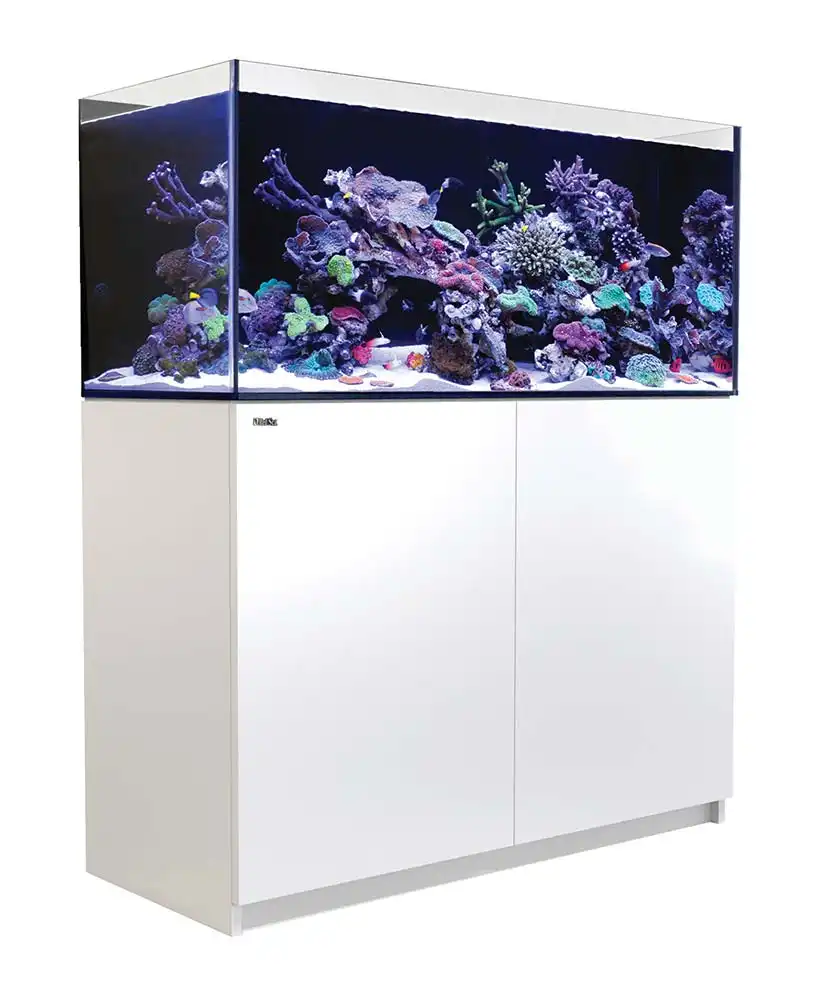


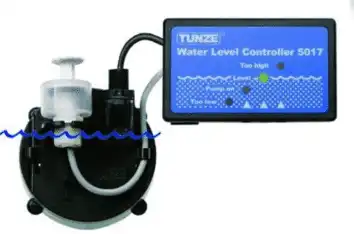
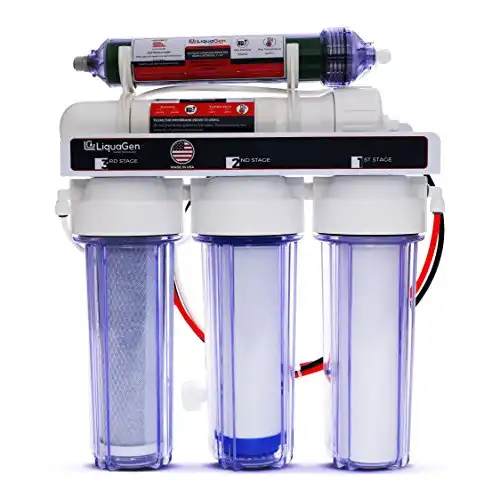


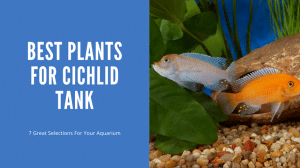
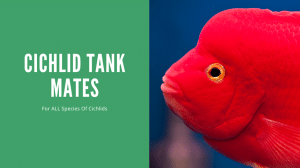
I had a marine tank set up for years only using under-gravel filtration, three power heads turned the tank water over in 45 minutes. I built the tank myself using 3/8″ float glass the tank size was 6′ x 2′ x 2′. I also installed a protein skimmer.
The under-gravel filter medium was crushed cockle shell ranging from 3″ depth at the rear of the tank to a 1″ depth at the front of the tank. Then there was another 1″ of coral sand on top of the crushed cockle shell. The tank had fish; hermit crabs a coral banded shrimp plus live rock.
Lighting I used was called North Light.
I find it surprising that assembling the right aquarium for your fish makes it easier to care for them and prolong their lifespan. My friend is interested in owning fish as his first-ever pet. Maybe we should look for a pet store that can provide the right aquarium for his needs.